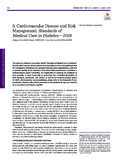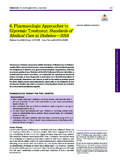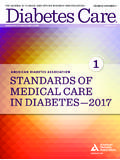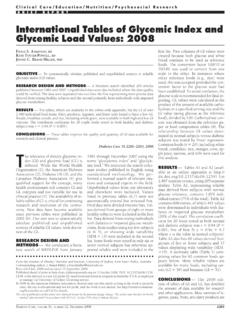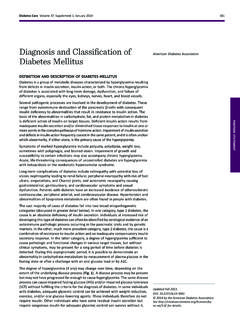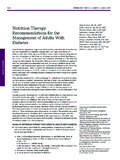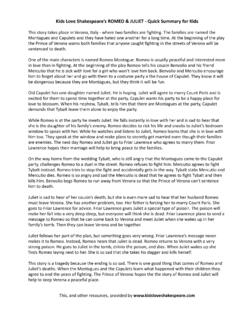Transcription of The Summary of Diabetes Self-Care Activities Measure
1 Epidemiology/Health Services/Psychosocial Research O R I G I N A L A R T I C L E. The Summary of Diabetes Self-Care Activities Measure Results from 7 studies and a revised scale DEBORAH J. TOOBERT, PHD The least defensible of these is the practice of SARAH E. HAMPSON, PHD using measures of Diabetes control, such as RUSSELL E. GLASGOW, PHD glycated hemoglobin or physicians' judg- ments, as indicators of patients' Self-Care behaviors (5,8 10). Direct methods, includ- ing observation of skills such as glucose test- ing and monitoring ( , by pill counts and OBJECTIVE To review reliability, validity, and normative data from 7 different studies, activity monitors), are labor-intensive and involving a total of 1,988 people with Diabetes , and provide a revised version of the Summary subject to reactivity (10).
2 Patients' self- of Diabetes Self-Care Activities (SDSCA) Measure . reports are also open to bias but can be made more reliable (11); for example, by RESEARCH DESIGN AND METHODS The SDSCA Measure is a brief self-report questionnaire of Diabetes self-management that includes items assessing the following aspects asking specific, nonjudgmental questions in of the Diabetes regimen: general diet, specific diet, exercise, blood-glucose testing, foot care, interviews (12) or questionnaires (13). and smoking. Normative data (means and SD), inter-item and test-retest reliability, correla- Moreover, the extent to which participants'. tions between the SDSCA subscales and a range of criterion measures, and sensitivity to self-reports of Self-Care are vulnerable to change scores are presented for the 7 different studies (5 randomized interventions and 2 biases such as social desirability can be observational studies).
3 Assessed with measures that tap constructs, such as the tendency to give self-reports that RESULTS Participants were typically older patients, having type 2 Diabetes for a number are self-deceptive (highly desirable but hon- of years, with a slight preponderance of women. The average inter-item correlations within estly held), and impression management scales were high (mean = ), with the exception of specific diet; test-retest correlations were (the conscious tendency to give highly desir- moderate (mean = ). Correlations with other measures of diet and exercise generally sup- ported the validity of the SDSCA subscales (mean = ). able self-reports) (14,15). Diabetes Self-Care includes a range of CONCLUSIONS There are numerous benefits from standardization of measures across Activities ( , self-monitoring of blood glu- studies.)
4 The SDSCA questionnaire is a brief yet reliable and valid self-report Measure of dia- cose, eating a low-saturated-fat diet, and betes self-management that is useful both for research and practice. The revised version and checking one's feet) and it is now well estab- its scoring are presented, and the inclusion of this Measure in studies of Diabetes self-man- lished that these different components do agement is recommended when appropriate. not correlate highly (16 18). Because self- care is multidimensional, it is necessary to Diabetes Care 23:943 950, 2000 assess each component separately rather than to combine scores across components (10). However, earlier self-report measures ecause the vast majority of the day-to- often seen as undependable.
5 This article of Diabetes Self-Care , such as the Diabetes B day care inherent in Diabetes is han- dled by patients and their families (1,2), there is an important need for reliable and valid measures of Diabetes self-manage- summarizes data drawn from 7 different studies on the norms, reliability, validity, and sensitivity to change of the Summary of Dia- betes Self-Care Activities (SDSCA) Measure , Regimen Adherence Questionnaire (19). and the self-report Measure of compliance developed by Cerkoney and Hart (20) and used in several subsequent studies (13,21, ment (3 6). Such measures are useful both a brief self-report instrument for measuring 22), combined responses across the differ- for clinicians and educators treating indi- levels of self-management across different ent regimen areas to produce a total adher- vidual patients and for researchers evaluat- components of the Diabetes regimen (7).
6 Ence or compliance score. In contrast, the ing new approaches to care. Self-report is by Generalizing from past research on dia- self-report Measure developed by Orme and far the most practical and cost-effective betes self-management is made difficult by Binik (18), adapted from the Rand Corpo- approach to Self-Care assessment, and yet is the heterogeneity of Self-Care measures used. ration diabetic adherence questionnaire (23), assessed the frequency with which From the Chronic Illness Research Group ( ), Oregon Research Institute, Eugene, Oregon; the Depart- behaviors were performed for 5 separate ment of Psychology ( ), University of Surrey, Guildford, ; and Behavioral and Community Studies Self-Care areas. Similarly, Johnson et al. (24).
7 ( ), AMC Cancer Research Center, Denver, Colorado. developed a 24-h recall interview to address Address correspondence and reprint requests to Deborah J. Toobert, PhD, Oregon Research Institute, 1715 13 aspects of the Diabetes regimen that form Franklin Blvd., Eugene, OR 97403-1983. E-mail: 4 independent factors: exercise, injection, Received for publication 16 December 1999 and accepted in revised form 5 April 2000. Abbreviations: SDSCA, Summary of Diabetes Self-Care Activities . diet type, and eating/testing frequency (25). A table elsewhere in this issue shows conventional and Syst me International (SI) units and conversion The original SDSCA Measure (7). factors for many substances. assessed 5 aspects of the Diabetes regimen: Diabetes CARE, VOLUME 23, NUMBER 7, JULY 2000 943.
8 Self-Care Measure general diet, specific diet, exercise, medica- The SDSCA has been administered as a divided by the square root of the sum of the tion taking, and blood-glucose testing. More self-completion questionnaire in paper- variances of change scores in the control recent studies using the scale have also and-pencil form (31,33,34), via a touch- and intervention groups. Second, 2-tailed included items on foot care and smoking. screen computer (29,32), and over the Student's t tests were used to evaluate Similar to the Rand Corporation question- Internet (28,30). change from baseline to post-test assess- naire, respondents report on the frequency ment among participants in the treatment with which they performed various activi- Statistical analysis condition of each intervention study that ties over the previous 7 days.
9 The SDSCA Statistical software package SPSS for Win- targeted change on a given behavior. assesses levels of Self-Care and not adher- dows version (SPSS, Chicago) was used ence or compliance to a prescribed regimen for all analyses. The characteristics and nor- RESULTS All of the participants were because of the difficulties associated with mative data for each study sample are adults, and the large majority had type 2. identifying, for a given patient, a specific expressed as means SD and percentages. Diabetes for a number of years. The mean unchanging standard against which behav- The SDSCA scales are based on items that, ages of the 7 samples ranged from 45 to 67. ior should be compared (10,26,27). in some studies, were worded, responded years of age and average Diabetes duration This article reports on the use of the to, and scored slightly differently from each ranged from to years (Table 1).
10 In SDSCA in 7 recent studies in which SDSCA other. Some of the variations in items were 6 of the 7 studies, there were slightly more data have not previously been reported, based on the time frame of the study, such women than men. The proportion of par- involving 1,988 people with Diabetes as looking at the previous month instead of ticipants taking insulin ranged widely from (28 34). Given earlier studies using this the previous 7 days. Most of the wording to 67%. The means and SDs for each Measure (35 37), including a survey of differences between studies were trivial. In subscale for each study provide informa- 2,000 people with Diabetes across the studies conducted during the early 1990s, tion for comparative purposes (higher per- (38), the SDSCA is probably the most widely we worded the first diet item as follows: centages indicate better Self-Care on all used self-report instrument for measuring Over the last 7 days, how often did you scales).
